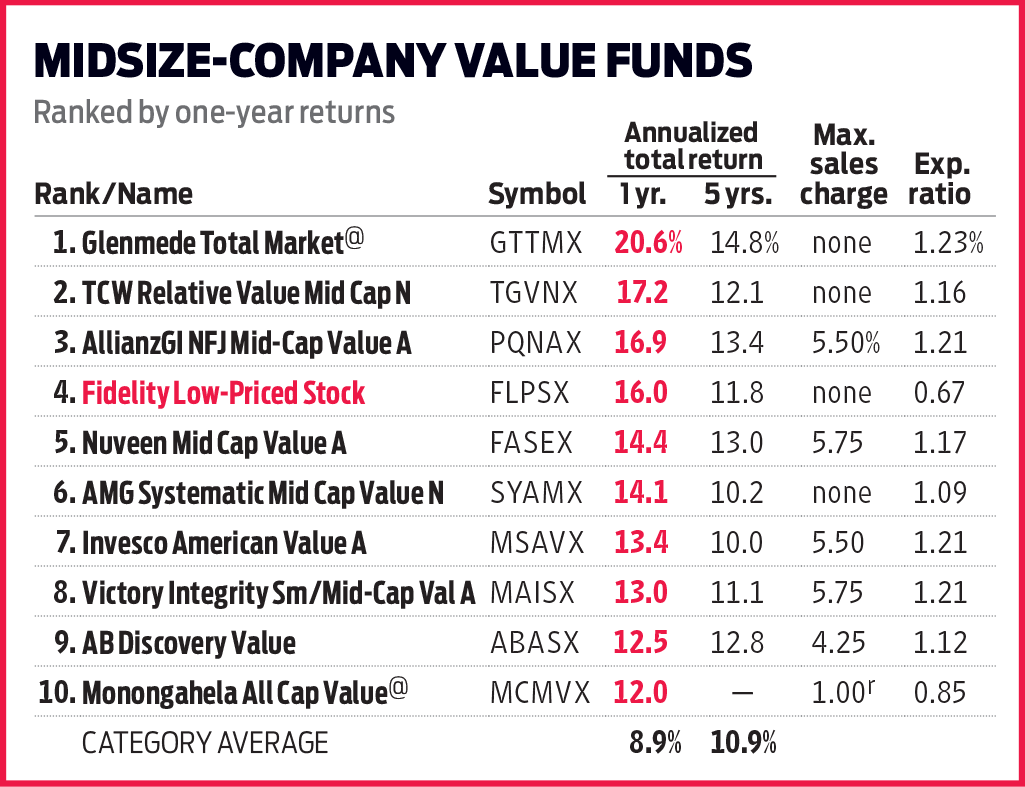Fidelity Low-Priced Stock: A Good Eye for Bargains
Legendary manager Joel Tillinghast finds plenty of solid stocks for $35 per share or less.

When it debuted back in 1989, Fidelity Low-Priced Stock (FLPSX) invested mostly in small-company stocks trading at $15 per share or less. Had you invested then, you'd scarcely recognize today's portfolio, which has 40% of assets in midsize companies and another 34% in large firms. You'd have also enjoyed an average annualized return of 13.8%–four percentage points better than Standard & Poor's 500-stock index.
Manager Joel Tillinghast, who has helmed the fund since its inception, has stuck to the same basic stock-picking formula, although the price tags for the stocks he shops for are a bit higher today. To be considered for the portfolio, a stock must now trade at $35 or less at the time of purchase or boast a price-earnings ratio less than that of the median stock in the small-company Russell 2000 index, which is still the fund's benchmark. Beyond that, Tillinghast and his team (six comanagers oversee a small portion of the fund) hunt for fast-growing firms trading cheaply compared with their "intrinsic value," which Tillinghast and company determine by analyzing the strength of a firm's balance sheet, the stability of its revenues and its competitiveness within its industry.

The fund holds 950 stocks; the top holdings represent the stocks the managers like most and those with the largest market capitalizations. The fund's size ($37.4 billion in assets at last check) generally prevents it from taking large positions in smaller firms. Many of the fund's holdings represent less than 0.1% of total assets.

Sign up for Kiplinger’s Free E-Newsletters
Profit and prosper with the best of expert advice on investing, taxes, retirement, personal finance and more - straight to your e-mail.
Profit and prosper with the best of expert advice - straight to your e-mail.
Funds with a glut of assets and an expansive portfolio tend to mirror their benchmarks, but Tillinghast separates Low-Priced Stock from its bogey and its peers by looking for values overseas. The fund allocates 41% of assets to foreign stocks, compared with 3% for the average value-oriented mid-cap fund and less than 1% for the Russell 2000. The fund has 10% of assets invested in small Japanese firms, which Tillinghast says trade at reasonable prices, with stronger balance sheets than comparable firms in the rest of the developed world. If value-investing guru Benjamin Graham were alive today, Tillinghast says, "he'd be learning Japanese."
Get Kiplinger Today newsletter — free
Profit and prosper with the best of Kiplinger's advice on investing, taxes, retirement, personal finance and much more. Delivered daily. Enter your email in the box and click Sign Me Up.

Ryan joined Kiplinger in the fall of 2013. He wrote and fact-checked stories that appeared in Kiplinger's Personal Finance magazine and on Kiplinger.com. He previously interned for the CBS Evening News investigative team and worked as a copy editor and features columnist at the GW Hatchet. He holds a BA in English and creative writing from George Washington University.
-
 Stock Market Today: Stocks Gain on Tech, Auto Tariff Talk
Stock Market Today: Stocks Gain on Tech, Auto Tariff TalkThe Trump administration said late Friday that it will temporarily halt tariffs on some Chinese tech imports.
By Karee Venema Published
-
 Sam's Club Plans Aggressive Expansion: Discover Its New Locations
Sam's Club Plans Aggressive Expansion: Discover Its New LocationsSam's Club expansion plans will open up to 15 new stores each year. Learn where they plan to open in 2025.
By Sean Jackson Published
-
 The 5 Best Actively Managed Fidelity Funds to Buy Now
The 5 Best Actively Managed Fidelity Funds to Buy Nowmutual funds In a stock picker's market, it's sometimes best to leave the driving to the pros. These Fidelity funds provide investors solid active management at low costs.
By Kent Thune Last updated
-
 The 12 Best Bear Market ETFs to Buy Now
The 12 Best Bear Market ETFs to Buy NowETFs Investors who are fearful about the more uncertainty in the new year can find plenty of protection among these bear market ETFs.
By Kyle Woodley Published
-
 Don't Give Up on the Eurozone
Don't Give Up on the Eurozonemutual funds As Europe’s economy (and stock markets) wobble, Janus Henderson European Focus Fund (HFETX) keeps its footing with a focus on large Europe-based multinationals.
By Rivan V. Stinson Published
-
 Vanguard Global ESG Select Stock Profits from ESG Leaders
Vanguard Global ESG Select Stock Profits from ESG Leadersmutual funds Vanguard Global ESG Select Stock (VEIGX) favors firms with high standards for their businesses.
By Rivan V. Stinson Published
-
 Kip ETF 20: What's In, What's Out and Why
Kip ETF 20: What's In, What's Out and WhyKip ETF 20 The broad market has taken a major hit so far in 2022, sparking some tactical changes to Kiplinger's lineup of the best low-cost ETFs.
By Nellie S. Huang Published
-
 ETFs Are Now Mainstream. Here's Why They're So Appealing.
ETFs Are Now Mainstream. Here's Why They're So Appealing.Investing for Income ETFs offer investors broad diversification to their portfolios and at low costs to boot.
By Nellie S. Huang Published
-
 Do You Have Gun Stocks in Your Funds?
Do You Have Gun Stocks in Your Funds?ESG Investors looking to make changes amid gun violence can easily divest from gun stocks ... though it's trickier if they own them through funds.
By Ellen Kennedy Published
-
 How to Choose a Mutual Fund
How to Choose a Mutual Fundmutual funds Investors wanting to build a portfolio will have no shortage of mutual funds at their disposal. And that's one of the biggest problems in choosing just one or two.
By Coryanne Hicks Published